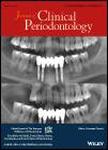版权所有:内蒙古大学图书馆 技术提供:维普资讯• 智图
内蒙古自治区呼和浩特市赛罕区大学西街235号 邮编: 010021

作者机构:Department of Hard Tissue Engineering Graduate School Tokyo Medical and Dental University Tokyo Japan National Taiwan University Hospital National Taiwan University Taipei Taiwan Department of Periodontology Faculty of Dentistry Khon Kaen University Khon Kaen Thailand Department of Periodontics and Oral Medicine Beijing Stomatological Hospital Capital Medical University Beijing China Department of Vascular and Applied Surgery Graduate School Tokyo Medical and Dental University Tokyo Japan Tsukuba Vascular Center Buerger Disease Research Institute Ibaragi Japan Institute of Advanced Biomedical Engineering and Science Tokyo Women's Medical University Tokyo Japan Global Center of Excellence Program International Research Center for Molecular Science in Tooth and Bone Diseases Tokyo Medical and Dental University Tokyo Japan Department of Periodontology and Endodontology Health Science University of Hokkaido Ishikari-gun Hokkaido 061-0293 1757 Kanazawa Tobetsu-cho Japan
出 版 物:《Journal of Clinical Periodontology》 (J. Clin. Periodontol.)
年 卷 期:2009年第36卷第10期
页 面:830-835页
学科分类:1003[医学-口腔医学] 1002[医学-临床医学] 100212[医学-眼科学] 10[医学]
主 题:β-2-glycoprotein I Anti-cardiolipin antibody Buerger disease Molecular mimicry Periodontitis
摘 要:Aim: Anti-cardiolipin (CL) antibodies can be induced in Buerger disease (BD), an inflammatory occlusive disorder affecting peripheral blood vessels, in response to bacteria bearing homology to the TLRVYK peptide of a phospholipid-binding plasma protein β-2-glycoprotein I. TLRVYK homologies are present in Porphyromonas gingivalis (TLRIYT) and Treponema denticola (TLALYK). This study investigated the association between periodontal infection and anti-CL antibodies in BD patients. Material and Methods: Periodontal conditions were examined in 19 BD patients and 25 systemically healthy control subjects. All subjects were heavy smokers. Serum anti-CL, anti-TLRVYK, anti-TLRIYT, and anti-TLALYK antibodies were assessed using the enzyme-linked immunosorbent assay. Results: BD patients had a significantly higher prevalence of periodontitis, more severe periodontal destruction and increased titres of serum anti-CL, anti-TLRVYK, anti-TLRIYT, and anti-TLALYK antibodies compared with healthy subjects. The levels of anti-CL antibodies positively correlated with those of the three anti-peptide antibodies. Anti-CL antibody titres were significantly associated with the percentage of sites with clinical attachment level ≥4 mm in BD patients. Conclusion: Elevated anti-CL antibody levels were associated with periodontal destruction in BD patients. Periodontopathic bacteria may serve as exogenous antigens that stimulate the anti-CL antibody production through molecular mimicry between the bacterial peptides and a host plasma protein. © 2009 John Wiley & Sons A/S.